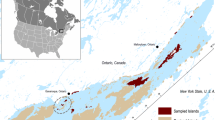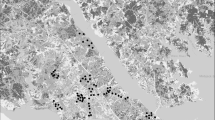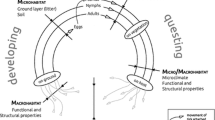Abstract
The density of Ixodes ricinus ticks in a heterogeneous landscape of northern Spain was determined and associated with some aspects of habitat topology. The habitat mosaic was used to quantify connectivity between patches of different tick density. The analysis revealed that patches with high tick abundance are ‘stepping-stone’ territories that, when removed from the landscape, cause large changes in connectivity. Sites with medium tick abundance do not cause such a critical transition in connectivity. Patches with low tick abundance, but optimal abiotic conditions for survival are located within the minimum cost corridors network joining the patches, while those sites where the tick has been intermittently collected are located at variable distances from this network. These results suggest that tick distribution in a zone is highly affected not only by abiotic variables (vegetation and weather) but also by host movements. Whether these high-density ‘stepping-stone’ patches occur in other tick species needs to be evaluated because of the potential implications of these foci for human health.
Similar content being viewed by others
References
Daniel, M. and Dusbábek, F. 1994. Micrometeorological and microhabitat factors affecting maintenance and dissemination of tick-borne diseases in the environment. In: 'Ecological Dynamics of Tick-borne Zoonoses', D.E. Sonenshine and T.N. Mather (eds), pp. 91-138. Oxford, New York.
Estrada-Peña, A. 1999. Geostatistics as predictive tools to estimate Ixodes ricinus (Acari: Ixodidae) habitat suitability in the western Palearctic from AVHRR satellite imagery. Exp. Appl. Acarol. 22: 337-349.
Estrada-Peña, A. 2001. Distribution, abundance, and habitat preferences of Ixodes ricinus (Acari: Ixodidae) in Northern Spain. J. Med. Entomol. 38: 361-370.
Gray, J.S., Kahl, O., Robertson, J., Daniel, M., Estrada-Peña, A., Gettinby, G., Jaenson, T.G.T., Jensen, P. and Jongejan, F. 1998. Lyme borreliosis habitat assessment. Zentbl. Bakteriol. 287: 211-228.
Hames, R.S., Rosenberg, A., Lowe, J. and Dhondt, A. 2001. Site reoccupation in fragmented landscapes: testing predictions of metapopulation theory. J. Anim. Ecol. 70: 182-190.
Hanski, I. 1994. Patch-occupancy dynamics in fragmented landscapes. Trends Ecol. Evol. 9: 131-135.
Keitt, T.H., Urban, D.L. and Milne, B.T. 1997. Detecting critical scales in fragmented landscapes. Conserv. Ecol. (online) 1: 4. URL: <http://www.consecol.org/vol1/iss1/art4>.
Lande, R. 1988. Genetics and demography in biological conservation. Science 241: 1455-1460.
Olivieri, I., Couvet, D. and Gouyon, P.-H. 1995. Metapopulation genetics and the evolution of dispersal. Am. Nat. 146: 202-208.
Patton, D.R. 1975. A diversity index for quantifying habitat "edge". Wild. Soc. Bull. 3: 171-173.
Shaffer, M.L. 1981. Minimum population size for species conservation. Bioscience 31: 131-134.
Stauffer, D. and Aharony, A. 1985. Introduction to Percolation Theory. Taylor & Francis, London.
Verboom, J., Foppen, R., Chardon, P., Opdam, P. and Luttikhuizen, P. 2001. Introducing the key patch approach for habitat networks with persistent populations: an example for marshland birds. Biol. Conserv. 100: 89-101.
Witt, K.A. 1994. Using fractal analysis to assess how species perceive landscape structure. Landscape Ecol. 9: 25-36.
Author information
Authors and Affiliations
Rights and permissions
About this article
Cite this article
Estrada-Peña, A. Understanding the Relationships between Landscape Connectivity and Abundance of Ixodes ricinus Ticks. Exp Appl Acarol 28, 239–248 (2002). https://doi.org/10.1023/A:1025362903620
Issue Date:
DOI: https://doi.org/10.1023/A:1025362903620




